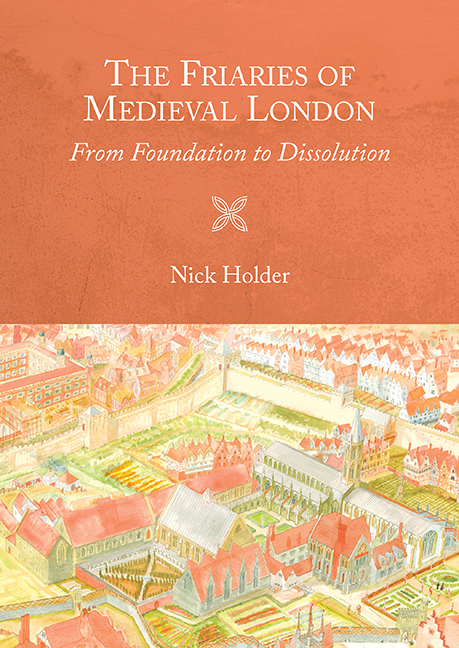Book contents
- Frontmatter
- Contents
- List of Illustrations and Tables
- Contributors
- Acknowledgements
- Abbreviations
- Introduction
- Part I The Nine London Friaries
- Part II The London Friars and their Friaries
- 10 Churches
- 11 Precincts and the Use of Space
- 12 Architecture and Architectural Fragments of the London Friaries
- 13 Floor Tiles and Building Materials from the London Friaries
- 14 Water Supply
- 15 Economy
- 16 Spiritual Life and Education in the London Friaries
- 17 Burial and Commemoration in the London Friaries
- 18 London Friars and Londoners
- 19 Dissolution
- Conclusions
- Timeline
- Bibliography
- Index
- Miscellaneous Endmatter
11 - Precincts and the Use of Space
from Part II - The London Friars and their Friaries
Published online by Cambridge University Press: 16 May 2018
- Frontmatter
- Contents
- List of Illustrations and Tables
- Contributors
- Acknowledgements
- Abbreviations
- Introduction
- Part I The Nine London Friaries
- Part II The London Friars and their Friaries
- 10 Churches
- 11 Precincts and the Use of Space
- 12 Architecture and Architectural Fragments of the London Friaries
- 13 Floor Tiles and Building Materials from the London Friaries
- 14 Water Supply
- 15 Economy
- 16 Spiritual Life and Education in the London Friaries
- 17 Burial and Commemoration in the London Friaries
- 18 London Friars and Londoners
- 19 Dissolution
- Conclusions
- Timeline
- Bibliography
- Index
- Miscellaneous Endmatter
Summary
THE seven London friaries were much more than churches: at the very least the friars required food and accommodation to sustain their duties of prayer and preaching. As the numbers of friars increased (along with the ambitions of priors), they came to need other buildings: libraries and schools for study, cloisters for traditional monastic contemplation, service wings to supply the kitchen, and gardens for horticulture and leisure. And both friars and lay people required accommodation after death in cemeteries. The size and layout of these priories thus developed over time, as needs changed and as the sponsorship of Londoners and others permitted.
The early friaries in the thirteenth century
The needs of the thirteenth-century friars of London were relatively simple: a plot on which to build a church and an accommodation wing, with space for a small cemetery. The location and basic shape of the early friary precincts were to a large extent a matter of chance – the result of accepting the foundation bequest of a patron, usually in the form of a parcel of land not a purse of money. The Dominicans, Carmelites and Pied friars were given their friary plots outside the old Roman wall that defined London; the Franciscans, Austin, Sack and Crossed friars were given intramural urban plots for their priories (Figure 69). This urban/suburban distinction explains the varying size of the early friaries: the Black, White and Pied friars were given fields or closes (over 3 acres in the case of the White friars) whereas the others had smaller urban messuages (a tenth of an acre for the Sack friars: Figure 69). The varying origins of the friaries also created differences in the priors’ ability to enlarge and adapt their friaries. So, during the two decades after they established their London house, the Crossed friars only managed to add one neighbouring messuage to their precinct (Figure 53; Table 11) but in the same period the Black friars acquired six additional suburban plots or closes (Figure 4; Table 3).
Although the documentary and archaeological evidence is generally lacking in detail for this early period in the friars’ history, the Grey Friars Register and the account of the early Franciscan Thomas of Eccleston suggest that the early guardians concentrated on building a small chapel followed by a single accommodation wing.
- Type
- Chapter
- Information
- The Friaries of Medieval LondonFrom Foundation to Dissolution, pp. 191 - 210Publisher: Boydell & BrewerPrint publication year: 2017



